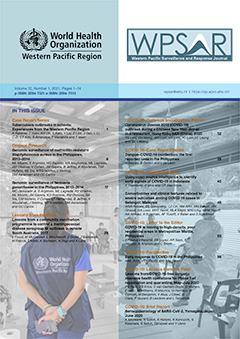Using open-source intelligence to identify early signals of COVID-19 in Indonesia
DOI:
https://doi.org/10.5365/wpsar.2020.11.2.010Abstract
Objective: Open-source data from online news reports and informal sources may provide information about outbreaks before official notification. This study aims to evaluate the use of open-source data from the epidemic observatory, EpiWATCH, to identify the early signals of pneumonia of unknown cause as a proxy for COVID-19 in Indonesia.
Methods: Using open-source data on pneumonia of unknown cause in Indonesia between 1 November 2019 and 31 March 2020 (extracted from EpiWATCH, an open-source epidemic observatory), a descriptive analysis was performed to identify the trend of pneumonia of unknown cause in Indonesia before official notification of COVID-19 cases.
Results: A rise in reports of pneumonia of unknown cause was identified in Indonesia, starting from late January 2020. There were 304 reported cases of pneumonia of unknown cause, 30 of which occurred before the identification of the first COVID-19 cases on 2 March 2020. The early signals of pneumonia of unknown cause in Indonesia may indicate possible unrecognized circulation of severe acute respiratory syndrome coronavirus 2 (SARS-CoV-2) before official detection.
Discussion: Open-source data may provide rapid, unvalidated information for early detection of outbreaks. Although unvalidated, such information may be used to supplement or trigger investigation and testing. As EpiWATCH sources global information, this methodology can be repeated for other countries within the Western Pacific Region, and for other diseases.
References
WHO. Coronavirus disease (COVID-19) outbreak [Internet]. 2020 [cited 2020 Apr 1]. Available from: https://www.who.int/westernpacific/emergencies/covid-19
Ministry of Health Singapore. Confirmed imported case of novel coronavirus infection in Singapore; multi-ministry taskforce ramps up precautionary measures. [Internet]. 2020 [cited 2020 Apr 1]. Available from: https://www.moh.gov.sg/news-highlights/details/confirmed-imported-case-of-novel-coronavirus-infection-in-singapore-multi-ministry-taskforce-ramps-up-precautionary-measures
Director-General of Health Malaysia. Kenyataan Akhbar KPK 26 Januari 2020 – Situasi Terkini Jangkitan Novel Coronavirus di Malaysia – (Press statement 26 January 2020- Current update on Novel Coronavirus Situation in Malaysia) [Internet]. 2020 [cited 2020 Apr 1]. Available from: https://kpkesihatan.com/2020/01/26/kenyataan-akhbar-kpk-26-januari-2020-situasi-terkini-jangkitan-novel-coronavirus-di-malaysia/
WHO. WHO Director-General’s opening remarks at the media briefing on COVID-19 - 11 March 2020 [Internet]. 2020 [cited 2020 Apr 1]. Available from: https://www.who.int/dg/speeches/detail/who-director-general-s-opening-remarks-at-the-media-briefing-on-covid-19---11-march-2020
Gorbiano MI. BREAKING: Jokowi announces Indonesia’s first two confirmed COVID-19 cases - National - The Jakarta Post. Jakarta Post [Internet]. Jakarta; 2020 Mar 2 [cited 2020 Apr 1]; Available from: https://www.thejakartapost.com/news/2020/03/02/breaking-jokowi-announces-indonesias-first-two-confirmed-covid-19-cases.html
Salazar PM De, Niehus R, Taylor A, Buckee CO, Lipsitch M. Identifying Locations with Possible Undetected Imported Severe Acute Respiratory Syndrome Coronavirus 2 Cases by Using Importation Predictions. Emerg Infect Dis J [Internet]. 2020;26(7). Available from: https://wwwnc.cdc.gov/eid/article/26/7/20-0250_article
Collier N. Uncovering text mining: a survey of current work on web-based epidemic intelligence. Glob Public Health [Internet]. 2012/07/11. Taylor & Francis; 2012;7(7):731–749. Available from: https://pubmed.ncbi.nlm.nih.gov/22783909
WHO. Epidemic intelligence - systematic event detection [Internet]. 2016 [cited 2020 Apr 3]. Available from: https://www.who.int/csr/alertresponse/epidemicintelligence/en/
ISER. Epiwatch | NHMRC Centre for Research Excellence, Integrated Systems for Epidemic Response [Internet]. [cited 2020 Apr 3]. Available from: https://iser.med.unsw.edu.au/epiwatch
Ministry of Health. COVID-19 update until April 1st 2020, 09.00 GMT+7 [Internet]. 2020 [cited 2020 Apr 1]. Available from: https://infeksiemerging.kemkes.go.id/category/situasi-infeksi-emerging/#.XoQ3x4gzZyw
Ministry of Health Indonesia. Pemerintah Perluas Lokasi Pemeriksaan Covid-19, Berikut Daftarnya [Government decided to expand the location for COVID-19 testing, here is the list] [Internet]. 2020 [cited 2020 Apr 4]. Available from: http://sehatnegeriku.kemkes.go.id/baca/rilis-media/20200320/3333441/pemerintah-perluas-lokasi-pemeriksaan-covid-19-berikut-daftarnya/
Aiello AE, Renson A, Zivich PN. Social Media– and Internet-Based Disease Surveillance for Public Health. Annu Rev Public Health [Internet]. Annual Reviews; 2020 Apr 2;41(1):101–118. Available from: https://doi.org/10.1146/annurev-publhealth-040119-094402
WHO. Report of the WHO-China Joint Mission on Coronavirus Disease 2019 (COVID-19) [Internet]. Geneva; 2020 Feb. Available from: https://www.who.int/docs/default-source/coronaviruse/who-china-joint-mission-on-covid-19-final-report.pdf

